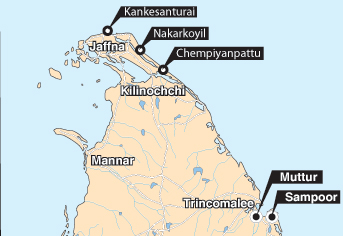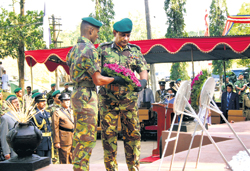 |
||||||
| |
||||||
|
9-hour sea battle: What was the Sea Tigers' agenda? Sri Lanka Navy's "Charlie Patrol" - a fleet of four Dvora fast attack craft (FAC) - was scouring the seas off the Jaffna peninsula last Friday evening. They were some three nautical miles from the coast when men on board one of the FACs spotted Sea Tiger boats approaching. It was around 7.30 p.m. and there were more than 20 boats. They radioed the Northern Naval Area headquarters in Kankesanthurai to say the boats, in three clusters, were moving. They sailed past the shores of Championpattu, Kudarappu and Nagerkovil. The Navy FACs moved in and gun battles erupted off the coast of Point Pedro. One cluster of boats headed northwards. Another veered westwards and came to the waters off Kankesanthurai. More naval craft moved in from KKS and the battle intensified. Eleven FACs were now engaging the Sea Tiger flotilla. A few hours later, nine more FACs from the Eastern Naval Area headquarters Trincomalee moved in. Army personnel and residents in the coastal areas of Point Pedro said flashes in the sky as the fighting raged resembled a massive fireworks display. Loud explosions were heard inland. It was past 3 a.m. when the fighting began to recede and Sea Tiger cadres began to withdraw in stages. Before the crack of dawn the battles were over. The Navy said they had damaged seven Sea Tiger boats and sunk five more. Before they went down, a Navy official said, there were loud explosions. This suggested that these boats were explosive laden and were used by suicide cadres. He claimed that the target was the Northern Naval Area headquarters located in the Kankesanthurai harbour and declared that over 80 guerrillas were killed.
Independent verification of the casualty figures is not possible. Two naval craft were also damaged and three sailors were wounded. There is no gainsaying the navy personnel bravely resisted several guerrilla attempts to fire at their vessels. The reasoning behind the claim that the KKS harbour was the target is because of ongoing security forces operations to secure Sampur. The Navy official argued that soon, with the recapture, the Eastern Naval Area headquarters in Trincomalee would be free of artillery attacks. Thus, the LTTE had planned to disrupt KKS, he argued. Whether the target was indeed the major navy base in the north remains a critical question. It is highly unlikely that the Liberation Tigers of Tamil Eelam (LTTE) would have mustered a cluster of some 20 or more Sea Tiger boats to launch an attack on what is easily the largest naval base in the north. Such a full frontal attack, with limited personnel and firepower, would have spelt disaster for the guerrillas. The Navy, with their superior strength and firepower, would have pulverized them. Quite apart from what the aim of the Sea Tiger thrust on Friday night was, there is a significant reality that has come to light. Substantially the Sea Tiger resources remain intact. This is despite the ongoing Eelam War IV where the LTTE suffered substantial losses to its cadres and damage to its bases due to bombings by the Air Force. The aim of the latter's exercise has been to destroy, if not weaken, the LTTE infrastructure. As the Navy says, it inflicted heavy damage and casualties to the Sea Tigers. Yet, the latter sustained the sea battles for some nine hours before backing out. In the light of the Sea Tigers thus retaining most of their resources and capability, there is no doubt; the defence establishment has to look beyond the possibility of the KKS harbour being the main target. There are a number of other important questions that arise. Among them: = Were the Sea Tigers planning an attack on major naval or shipping movements? Did they miss out on such a target? It is no secret that both civilian and military supplies from Trincomalee are transported via the northeastern seas to the Jaffna peninsula. The LTTE, at any cost, wants to interrupt this activity which is the life blood for some 40,000 troops and policemen in the peninsula. Proof of this came this week when the LTTE said that it was ready to allow food and medicine to the people of Jaffna to be transported along the A-9 highway. The LTTE conveyed its consent to the International Committee of the Red Cross (ICRC). They claimed that sea routes were being used by the military to re-supply. In offering to open its side of A-9 highway so, the LTTE is also keen to re-open its entry-exit points that have remained a major source of revenue to it. In fact the Omanthai side was open for civilians and food convoys on Friday. = Whether the Friday night's thrust by the Sea Tiger flotilla was a diversion? Were the rebels carrying out a mid sea transfer of any weaponry and did they want to keep the Navy patrols engaged? A sizeable number of naval craft were involved in battles with the Sea Tiger clusters. = Were the movements of the three clusters of Sea Tiger boats part of an exercise to test the strength and responses of the Navy? = Was the cluster of Sea Tiger boats planning to reach the shores somewhere in the peninsula to land its cadres for an attack or sabotage mission? Other than Friday night's incident, the Jaffna peninsula remained relatively calm except for occasional barrages of guerrilla mortar fire. They were directed at security forces positions. However, in the east the security forces operation to regain control of Sampur continues. Troops are moving cautiously since the area is heavily mined. Most of the fighting has been through indirect fire. It is only the recapture of Sampur and its environs that will remove the threat facing the port of Trincomalee, including the Navy's largest base. The ongoing operation will end only with the recapture. Thereafter, the security forces and even the police will have to dominate an area of some 180 square kilometres to make sure the Trincomalee port is safe.
Thus, the ongoing military operations seem to have one larger objective - to thwart a guerrilla siege on Jaffna and the Trincomalee port. In Jaffna, it is by directing artillery fire on the airbase halting regular military and civilian flights. In Trincomalee, it was directing artillery fire at the Dockyard where the Navy base is located thus threatening maritime movements from there. There were suspicions yesterday that the guerrillas may have moved their artillery guns away from Sampur in view of ongoing military operations. Whilst overcoming these tasks, they will have to ensure there is calm in other areas including the City of Colombo and suburbs. The guerrillas who are regrouping and re-training pose formidable challenges.
|
||||||
Copyright © 2001 Wijeya Newspapers
Ltd. All rights reserved. |
||||||

